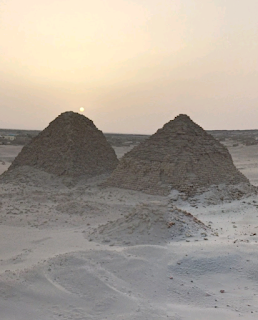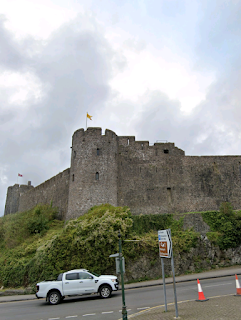The Nubian Pyramids built by the predecessors of Ethiopia are in what is now Sudan, the capital city of which is Khartoum. In the public consciousness this ancient civilization is somewhat overshadowed by Egypt, to the north, but it is one of the most important of early civilizations.
Khartoum, the capital city of Sudan, is located where the White Nile, from Lake Victoria, and the Blue Nile, flowing from Ethiopia, intersect. Khartoum originated as an Egyptian military outpost. It was founded by Ibrahim, the son of Muhammad Ali Pasha who broke away from the Ottoman Empire and founded the Pasha Dynasty in Egypt, that lasted until the overthrow of King Farouk in 1952.
Sudan was the largest country in Africa until it was split in 2011, with South Sudan becoming the world's newest nation. There is also conflict involving Darfur, the western part of Sudan that used to be an Islamic sultanate.Nubia is a region of northeast Africa that was a site of early civilization. The southern part of Nubia is in what is now Sudan. Nubians ruled Egypt for what is known as the 25th Dynasty of Ancient Egypt. Like the Egyptians, the Nubians built pyramids as tombs for royalty. Nubian pyramids are much smaller in scale, but much more numerous, than Egyptian pyramids.
The Old Kingdom of ancient Egypt built massive pyramids but this eventually fell out of favor and kings came to be buried at what is referred to as the "Valley of the Kings". King Tut, as one example, never had a pyramid but is buried here. We saw the Valley of the Kings in the posting on this blog, "Ramesses I". We saw the best-known Egyptian pyramids, at Giza, in "The Underground Orion Correlation Theory".
Building the smaller Nubian pyramids was much more sustainable that the Egyptian pyramids, and that is why there are so many more of the Nubian pyramids. We have already seen the Nubian pyramids at Meroe, in our visit to "Ethiopia", although the pyramids are actually in Sudan. The following pyramids are at Nuri. A pharaoh of Egypt that is mentioned in the Bible, Tarhaka, was actually a Nubian of the 25th Dynasty and has his tomb here.
There are multiple scenes following. To see the scenes, after the first one, you must first click the up arrow, ^, before you can move on to the next scene by clicking the right or forward arrow, >. After clicking the up arrow, you can then hide the previews of successive scenes, if you wish.
These Nubian pyramids and structures, some reconstructed, are at Karima. The first four images are from Google Street View.
https://www.google.com/maps/@18.5380981,31.8220521,3a,75y,253.5h,96.94t/data=!3m8!1e1!3m6!1sAF1QipOiCPeVxWDSUV0WY3mmeF7aoVqbdUioiJ7g4u3Q!2e10!3e11!6shttps:%2F%2Flh5.googleusercontent.com%2Fp%2FAF1QipOiCPeVxWDSUV0WY3mmeF7aoVqbdUioiJ7g4u3Q%3Dw203-h100-k-no-pi-6.941883-ya196.49998-ro0-fo100!7i8704!8i4352
The following scenes begin around the central area of Khartoum. The first six images are from Google Street View.
https://www.google.com/maps/@15.6000985,32.5288184,3a,75y,80h,90t/data=!3m8!1e1!3m6!1sAF1QipNYl80kIs3ZtHbtauzCymltiXhbq3E_03z8mCy6!2e10!3e11!6shttps:%2F%2Flh5.googleusercontent.com%2Fp%2FAF1QipNYl80kIs3ZtHbtauzCymltiXhbq3E_03z8mCy6%3Dw203-h100-k-no-pi-0-ya264.29434-ro0-fo100!7i6080!8i3040
This is around the University of Khartoum. The National Museum of Sudan has a lot of ancient Egyptian artifacts. Remember that the 25th Dynasty that ruled ancient Egypt was Nubian, from further south in Africa. The first image is from Google Street View.
https://www.google.com/maps/@15.6092655,32.5404897,3a,75y,163.5h,92.44t/data=!3m8!1e1!3m6!1sAF1QipPwSccO38qV5tEGk0xpzxaGl5g1h3TBsGQ7-Wk0!2e10!3e11!6shttps:%2F%2Flh5.googleusercontent.com%2Fp%2FAF1QipPwSccO38qV5tEGk0xpzxaGl5g1h3TBsGQ7-Wk0%3Dw203-h100-k-no-pi-2.4351845-ya352.5-ro-0-fo100!7i10240!8i4428
This is further east in Khartoum.
https://www.google.com/maps/@15.6131186,32.565581,3a,75y,34.5h,93t/data=!3m8!1e1!3m6!1sAF1QipMYNWRO_SmLlOEwM15c0XvOkYzfGc1uT7ZSnSmp!2e10!3e11!6shttps:%2F%2Flh5.googleusercontent.com%2Fp%2FAF1QipMYNWRO_SmLlOEwM15c0XvOkYzfGc1uT7ZSnSmp%3Dw203-h100-k-no-pi-2.9999962-ya294.5-ro0-fo100!7i6144!8i3072
In Khartoum North, notice how the Al Noor Islamic Center resembles the Hagia Sophia and the Tomb of Muhammad Ali Pasha, in Cairo. Remember that Khartoum was founded by the Pasha Dynasty. The first two images, inside the Al Noor, are from Google Street View.
https://www.google.com/maps/@15.6273377,32.5608524,3a,75y,271.5h,92.93t/data=!3m8!1e1!3m6!1sAF1QipNDi6d637iEWvEPb2cjMXE_xAsb5NUMi9_sBEV4!2e10!3e11!6shttps:%2F%2Flh5.googleusercontent.com%2Fp%2FAF1QipNDi6d637iEWvEPb2cjMXE_xAsb5NUMi9_sBEV4%3Dw203-h100-k-no-pi-2.9338646-ya271.5-ro-0-fo100!7i10000!8i5000
To the west of the Nile River from Khartoum is the city of Omdurman. The first four images of Omdurman are from Google Street View.





















































